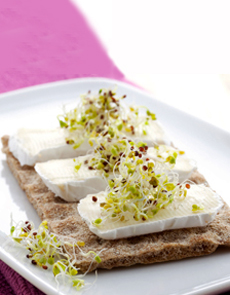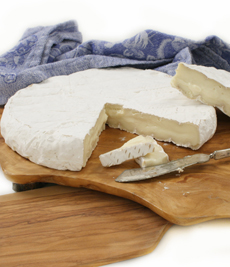
 Brie has found its way onto hors d’oeuvre and in appetizers like Baked Brie. Photo courtesy Île de France. Brie has found its way onto hors d’oeuvre and in appetizers like Baked Brie. Photo courtesy Île de France.
|
STEPHANIE ZONIS focuses on good foods and the people who produce them.
|
|
May 2007
Last Updated March 2012
|
 |
Brie And Camembert
Page 2: Brie
This is Page 2 of a four-page article on Brie and Camembert. Click on the black links below to visit other pages.
Origin Of Brie
Supposedly, Brie has been made since at least the fifth century, although there doesn’t seem to be any documentation to support this claim. Some experts believe Brie is a later variation of Coulommiers* (coo-lom-YAY), a cheese made in the town of the same name in the Seine-et-Marne department of France, just north of Île de France, where Brie is produced.
*Like Brie, Coulommiers is made from raw cow's milk, in a disc shape with white, bloomy edible Penicillium candidum rind. It is smaller and thicker than Brie but otherwise very similar in color and texture, with perhaps slightly nuttier flavor like Camembert.
According to legend, the Emperor Charlemagne is said to have tried Brie (and instantly become a devoted fan) as early as the year 774. Centuries later, in 1815, the Prince de Tallyrand named Brie “Le Roi de Fromages,” The King of Cheeses. (In 1782, the French philosopher Diderot had called Roquefort the “King of Cheeses,” declaring that “Roquefort cheese is without doubt the finest cheese in Europe.” Does a prince trump a philosopher?)
Cheese expert Steven Jenkins notes that, until the 1870 Franco-Prussian War, the plains of Brie were entirely given over to dairy cattle pastures. But the war wreaked havoc on the area’s dairy businesses, which never fully recovered. Land ownership shifted from small farmers to industry, and by 1914 only half as many cattle were being raised there, mostly for beef.
Cheese production was slow to recuperate after the First World War, and by the 1950s most Brie production had also become industrialized (made on machines in factories, not by hand by farmers).
There are two Bries with AOC designations, Brie de Meaux and Brie de Melun. Brie de Melun is made only of raw milk and is not exported, according to Jenkins. The Brie area is south and east of Paris, within the wider region of Île-de-France.
As with Camembert, the name of Brie is not protected, so it can appear on cheese produced in other regions and other countries, even on pasteurized impostors (Brie de Meaux, for instance, might be used as a brand name, which I regard as highly unethical).
The process used to make Brie is unsurprisingly very similar to that used for Camembert. Aside from geography, a key difference is that Brie is traditionally made in larger wheels, ranging from about 1 to 6 pounds (500g to 3kg) in weight, 9 to 15 inches in diameter and 1 to 1.5 inches in thickness, Due to consumer demands, it can be found in 8-ounce disks.
Camembert Vs. Brie: Aging
Camembert’s smaller size will affect it in several ways. A smaller wheel tends to age slightly more quickly. Gilles, a fromagier at Artisanal Premium Cheese in New York City, explains that the smaller size affords more rapid moisture loss and more concentration of flavor. The flavor of a true Camembert will always be a little stronger than that of a true Brie, says Gilles.
|
|

This Brie is made in Canada, and is certified kosher by Tablet K. It is available at iGourmet.com.
|
Continue To Page 3: Selecting A Ripe Brie Or Camembert
Go To The Article Index Above
Lifestyle Direct, Inc. All rights reserved. Images are the copyright of their respective owners.

|




 Brie has found its way onto hors d’oeuvre and in appetizers like Baked Brie. Photo courtesy Île de France.
Brie has found its way onto hors d’oeuvre and in appetizers like Baked Brie. Photo courtesy Île de France. 